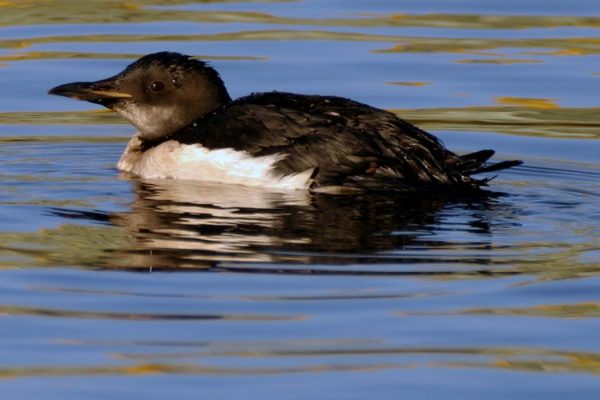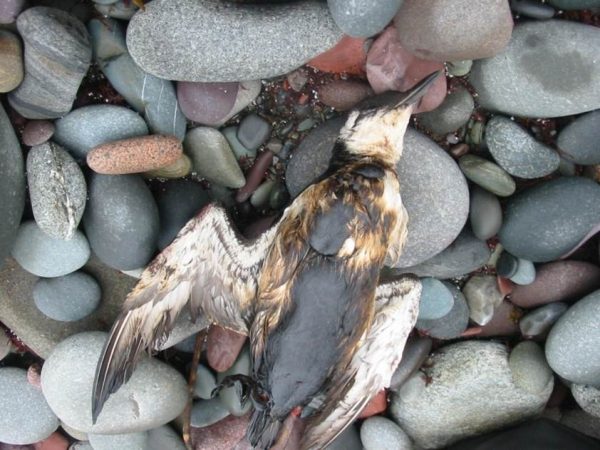TORONTO, May 26, 2016 – Seabirds exposed to even a dime-sized amount of oil can die of hypothermia in cold-water regions, but despite repeated requests by Environment Canada, offshore oil operators are failing when it comes to self-monitoring of small oil spills, says new research out of York University.
Chronic pollution from many small oil spills may have greater population-level impacts on seabirds than a single large spill, suggest researchers Gail Fraser and Vincent Racine of York U’s Faculty of Environmental Studies. However, seabirds are rarely considered in the monitoring of small spills from offshore oil production projects in Newfoundland and Labrador even though Environment Canada has asked that they be included.

Oiled Thick-billed Murre, Cripple Cove, Nfld, Nov. 28 2004. Photo credit Ian L. Jones
In an article published in the international journal, Marine Pollution Bulletin, Fraser and Racine looked at how offshore oil operators monitored and responded to small spills (less than 1,000 litres) for three production projects off the coast of Newfoundland and Labrador.
In three high-profile environmental assessments Environment Canada repeatedly requested that impacts on seabirds be monitored following small spills, but this has not happened.
“Industry self-monitoring of spills has failed to collect information that would allow researchers to understand the impact of chronic oil spills on seabirds,” said Fraser, who along with Racine is calling for independent observers on the offshore platforms. “Many seabird populations are declining and understanding sources of mortality is critical to their conservation.”

Oiled Common Murre, Cape Shore Newfoundland 4 December 2004. Photo by Bill Montevecchi
Fraser and Racine looked at reporting and monitoring of spills between 1997 and 2010. The researchers obtained operator spill reports under an Access to Information request. They found there were 220 daytime spills. Reporting on the presence or absence of seabirds was done in only 11 (five per cent) of the cases. The Canadian Wildlife Service’s seabird survey protocol should be followed when a spill occurs, but none of the reports showed evidence of that. The time it takes for a small spill to dissipate was also not in the spill reports and this information is required to estimate possible interactions of oil spilled with seabirds. “The lack of information on seabirds during oil spills indicates a need for third-party observers,” said Fraser.
The joint federal and provincial Newfoundland & Labrador the Canada-Newfoundland Labrador Offshore Petroleum Board (C-NLOPB) is responsible for administering environmental assessment follow-up procedures, including monitoring and responses to oil spills. The C-NLOPB has repeatedly rejected calls for independent, third party observers on platforms while seemingly being incapable of enforcing Environment Canada’s recommendations.
However, during the White Rose environmental assessment process the C-NLOPB publicly acknowledged “that should such circumstances arise, it is fully prepared to adopt a different regulatory approach, including consideration of full-time on-site oversight of the operations concerned.” While the circumstances were not defined, Fraser argues that “A failure to collect information on seabirds during oil spills for 13 years is sufficient to demand the regulatory approach be changed to include third-party observers.”
*Note: High res photos available, including the following.
York University is known for championing new ways of thinking that drive teaching and research excellence. Our 52,000 students receive the education they need to create big ideas that make an impact on the world. Meaningful and sometimes unexpected careers result from cross-discipline programming, innovative course design and diverse experiential learning opportunities. York students and graduates push limits, achieve goals and find solutions to the world’s most pressing social challenges, empowered by a strong community that opens minds. York U is an internationally recognized research university – our 11 faculties and 24 research centres have partnerships with 200+ leading universities worldwide.
Media Contact:
Sandra McLean, York University Media Relations, 416-736-2100 ext. 22097 / sandramc@yorku.ca

